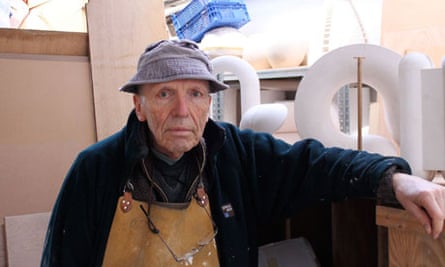I have been working as a sculptor since 1958 but only now, 55 years later, am I having my first solo show at the age of 78.
The delay is easily explainable – until 1986 I was fully occupied with teaching work and, more recently, by the demands of carrying out large-scale public commissions. I had not actively sought nor expected to become involved in gallery shows, but thanks to the enlightened policies of young gallerist Megan Piper, I am now able to bring together free-standing sculptures created over a number of years to her gallery.
I'm as excited by this as any aspiring young Turk might be given the opportunity of a first major showing.
My training was at the Slade School of Fine Art and, like art students then and now, I had hopes for early recognition and gallery exposure. However, this does not happen readily and other means have to be found to sustain one's practice. When I left Slade I had a family to support and for the next 28 years I made my living teaching in art schools, for much of the time as head of sculpture, and later as head of fine art, at Camberwell.
I exhibited regularly in group shows and for a while in the early 1960s the work was beginning to gain some critical attention. But cycles of taste and fashion in art are very much shorter than working lives and the attention didn't last long. I enjoyed teaching and the challenge of developing the school's work during a very turbulent but energising period.

The Coldstream art education reforms of the 1960s led to a reduction in the number of art schools but, for those who remained, there followed something of a golden age with very generous funding, supporting a great variety of approaches to making art. As my teaching responsibilities increased my time in the studio became more valuable and simply getting the work made was the priority – there was little or no time to promote it.
In 1983 I was invited by the Arts Council to select artists and take part in The Sculpture Show, exhibiting the work of 50 sculptors at the Hayward and Serpentine galleries. It was a very stimulating experience involving visits to many studios both here and abroad. It put me much more closely in touch with the professional art world and provided welcome relief from dealing with worrying developments at Camberwell, which included the major funding cuts introduced by the Thatcher government and closely related plans for a merger of the five London art schools.
My involvement with The Sculpture Show led to a radical change in my direction. A sculpture of mine in the show, Mnemonic, was sold to the Colchester District Hospital and permanently installed in an open courtyard. At the same time, the show was seen by a major collector, Derry Irvine, who commissioned me to make a very large limestone piece for his London garden, followed by another two years later.
At that time, I shared the prejudice of many of my generation against taking on commissioned work in the belief that it would impose unacceptable limits on my freedom of action in the studio. In practice, I found the opposite to be the case; the constraints stimulated invention and improved the resolution of the work.
Retiring from teaching in 1986 to concentrate on sculpture, I've had the good fortune to be offered a more or less continuous run of public commissions ever since. During the same period I have continued to make free-standing sculptures but my priority has been meeting the demands of the commissioned work in much the same way as I was earlier committed to teaching.
In 2010, I met Megan Piper who was planning to establish a new London gallery devoted to the work of artists who had been practising for at least 40 years. She was hoping that by giving prominence to experienced artists – who had possibly been bypassed by the conventional art world's focus on the young – she would be able to present interesting work that was new to the public by virtue of it having been, for the most part, previously unseen and unsung.
Megan's young team have a genuine enthusiasm for my work and have outdone themselves in their efforts to make this show a success, not least the contribution of Claudia Tobin, who has written a catalogue essay from which I have gained new insights into the significance of a lifetime's work.
Paul de Monchaux's Fixing Memory is at The Piper Gallery from 13 February to 15 March – follow the gallery on Twitter @ThePiperGallery or visit Paul's website
This content is brought to you by Guardian Professional. To get more articles like this direct to your inbox, sign up free to become a member of the Culture Professionals Network.

Comments (…)
Sign in or create your Guardian account to join the discussion